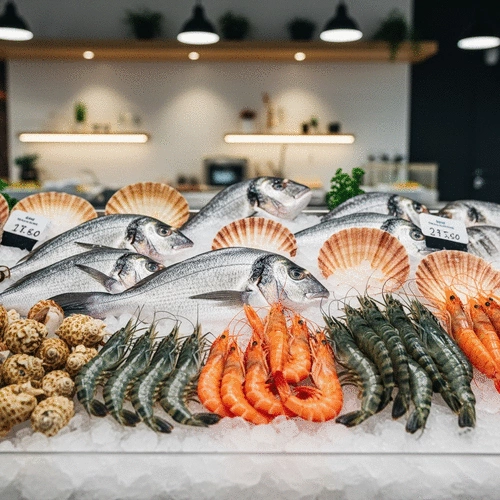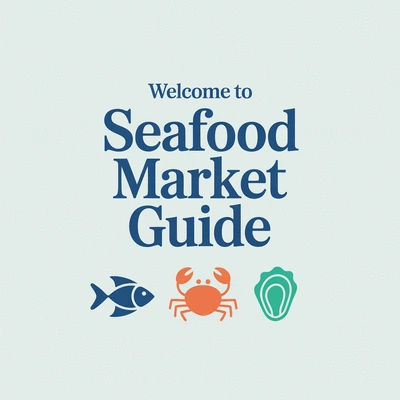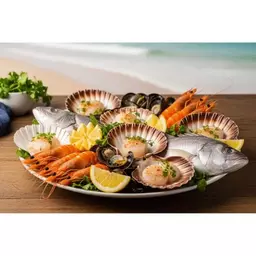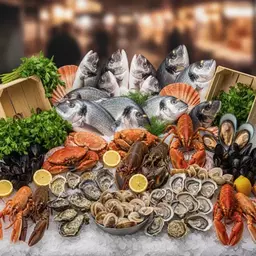Choosing the right seafood can make a world of difference, not just in flavor but also in health. With alarming rates of foodborne illnesses linked to stale seafood, making informed choices is more important than ever. Let’s explore how you can elevate your seafood experience by prioritizing freshness and sustainability.
What You Will Learn
- The Impact of Freshness: Fresh seafood enhances flavor, texture, and nutritional value, making meals more enjoyable and healthier.
- Health Risks of Stale Seafood: Consuming stale seafood increases the likelihood of foodborne illnesses and diminishes heart-healthy omega-3 fatty acids.
- Visual Indicators of Freshness: Look for clear eyes, bright red gills, and shiny skin to identify fresh seafood at the market.
- Resources for Sustainable Choices: Utilize tools like Seafood Watch and local guides to make informed and sustainable seafood selections.
- Engagement with Local Communities: Building connections with local fishmongers and attending sustainable fishing events can enhance your seafood knowledge and experience.
Key Points on Fresh vs. Stale Seafood
Understanding the differences between fresh and stale seafood is crucial for both health and taste. Below are some vital comparisons to keep in mind. You can find more detailed information on buying fresh seafood essential tips to ensure you make the best choices.
Benefits of Fresh Seafood
- Less risk of foodborne illness
- Rich in Omega-3 fatty acids
- Better digestion
Risks of Consuming Stale Seafood
- Higher chance of harmful bacteria
- Deterioration of nutritional value
- Unpleasant taste and texture
Understanding the Importance of Choosing Fresh Seafood
As a seafood enthusiast, I can't stress enough how crucial it is to choose fresh seafood when you're shopping at your local markets. Not only does freshness enhance the flavor, but it also impacts the overall quality and safety of the seafood you consume. Have you ever bitten into a piece of fish that just didn’t taste right? That’s often a sign of it not being fresh! Let's dive deeper into the role of freshness in seafood quality, and why it's so vital for both taste and health.
The Role of Freshness in Seafood Quality
Freshness is the cornerstone of seafood quality. When seafood is fresh, it retains its natural flavors, textures, and nutrients. Here are some key points to consider:
- Flavor: Fresh seafood often has a sweet, briny taste that speaks to its quality.
- Texture: The texture of fresh seafood is firm and resilient, giving you that satisfying bite.
- Nutritional Value: Fresh seafood is packed with vitamins and minerals that are essential for a balanced diet.
Choosing fresh fish not only elevates your meals but also fuels your body with the nutrients it needs! So, the next time you're at a market, take a moment to consider these aspects of quality.
Health Implications of Consuming Fresh vs. Stale Seafood
Did you know that eating stale seafood can pose serious health risks? Fresh seafood is not only tastier, but it’s also safer. Here’s why:
- Reduced Risk of Foodborne Illness: Fresh seafood is less likely to harbor harmful bacteria, which can thrive in older fish.
- Better Omega-3 Fatty Acids: Fresh fish is richest in heart-healthy omega-3s, which can deteriorate over time.
- Improved Digestion: Your body will digest fresh seafood better, enhancing your overall health.
At Seafood Market Guide, we emphasize the importance of freshness not just for flavor, but for your health, too! When you choose fresh seafood, you're not only treating your taste buds but also taking steps towards a healthier lifestyle. Learn more about making eco-friendly seafood choices for families to support both health and sustainability.
Visual Indicators of Fresh Seafood
When you're on the hunt for fresh seafood, your eyes can be your best asset! There are several visual indicators that can help you determine the freshness of fish and other sea catches. Let's explore these signs in detail.
Quick Summary
Here's a brief recap of the key points discussed so far:
- Freshness Matters: Fresh seafood enhances flavor, texture, and nutritional value.
- Health Risks: Stale seafood can harbor harmful bacteria and diminish omega-3 content.
- Visual Indicators: Clear eyes, bright gills, and shiny skin are key signs of freshness.
- Sustainability Resources: Utilize tools like Seafood Watch to make informed, sustainable choices.
Summarizing Fresh Seafood Selection Guidelines
Choosing fresh seafood can feel overwhelming, but it’s essential for quality and taste! At Seafood Market Guide, I’m here to simplify that process for you. To help you navigate your seafood selections, here are some key takeaways to keep in mind:
- Check the Eyes: Clear and bulging eyes are a sign of freshness.
- Gills Matter: Bright red gills indicate good quality seafood.
- Smell Test: Fresh seafood should smell like the ocean, not fishy.
- Skin Shine: Look for shiny, firm skin as a freshness indicator.
- Texture is Key: Fresh seafood should feel firm to the touch.
By keeping these guidelines in mind, you’ll find it much easier to choose the best seafood available. The freshness of your seafood not only enhances its taste but also ensures you’re making healthier choices for you and your loved ones! For more insights, explore Brisbane's sustainable seafood choices.
Resources for Sustainable Seafood Choices
In our quest for sustainable seafood, having the right resources can make all the difference. Here are some tools and guides that I find incredibly helpful when making seafood choices:
- Seafood Watch: An excellent resource for finding sustainable seafood options.
- Local Seafood Guides: Check for guides specific to your region that highlight responsible fishing practices.
- Mobile Apps: Utilize apps that offer seafood sustainability ratings and suggestions.
These resources empower you to make informed decisions, allowing your love for seafood to align with sustainable practices. Remember, supporting local markets not only benefits you but also helps preserve our oceans!
Engaging with Your Local Seafood Community
Engaging with your local seafood community can enrich your experience and deepen your understanding of sustainable practices. Here are ways to connect:
- Visit Local Fishmongers: Building relationships with them can lead to insider tips on freshness and sourcing.
- Participate in Sustainability Initiatives: Join local events focusing on sustainable fishing practices.
- Attend Workshops: Look for cooking demonstrations and workshops on seafood preparation.
By connecting with your local seafood community, you not only support local economies but also enhance your own culinary journey. I always enjoy meeting fellow seafood lovers and sharing insights on markets and recipes! You can discover more about fresh seafood markets in Australia.
Encouraging Questions and Further Learning
As we wrap up this seafood journey together, I encourage you to explore further! Here are some ways to enhance your knowledge and share your experiences:
- FAQs About Seafood Freshness: Always ask questions! If you’re unsure, don't hesitate to ask fishmongers about their products.
- Share Your Tips: Have you discovered a great cooking method or recipe? Let’s swap ideas!
- Explore Cooking Methods: Consider trying a new recipe every week to expand your seafood repertoire!
Engaging with others about seafood not only enhances your own knowledge but can also inspire friends and family to appreciate the richness of Australian seafood. So, what’s your next seafood adventure? Let’s dive into the world of flavors together!
Frequently Asked Questions About Fresh Seafood
Q: Why is freshness important when choosing seafood?
A: Freshness is crucial because it directly impacts flavor, texture, and nutritional value. Fresh seafood offers a sweeter, brinier taste, a firm texture, and retains essential omega-3 fatty acids and vitamins. It also significantly reduces the risk of foodborne illnesses.
Q: What are the health risks of consuming stale seafood?
A: Consuming stale seafood increases the likelihood of foodborne illnesses due to harmful bacteria. It also leads to a deterioration of nutritional value, particularly omega-3 fatty acids, and results in an unpleasant taste and texture.
Q: How can I visually identify fresh seafood at the market?
A: Look for clear, bulging eyes, bright red gills, and shiny, firm skin. Fresh seafood should also have a mild, ocean-like smell, not a strong "fishy" odor. The flesh should feel firm to the touch.
Q: What resources are available to help me make sustainable seafood choices?
A: Excellent resources include Seafood Watch, which provides sustainability ratings. You can also look for local seafood guides specific to your region and utilize mobile apps that offer sustainability ratings and suggestions for responsible fishing practices.
Q: How can engaging with my local seafood community enhance my experience?
A: Building relationships with local fishmongers can provide insider tips on freshness and sourcing. Participating in sustainability initiatives and attending workshops on seafood preparation can deepen your understanding and enhance your culinary journey while supporting local economies.
Recap of Key Points
Here is a quick recap of the important points discussed in the article:
- Freshness Matters: Fresh seafood enhances flavor, texture, and nutritional value.
- Health Safety: Consuming fresh seafood reduces the risk of foodborne illnesses and ensures better digestion.
- Visual Indicators: Look for clear eyes, bright gills, and shiny skin when selecting seafood.
- Sustainable Choices: Utilize resources like Seafood Watch for sustainable seafood options.
- Community Engagement: Connect with local fishmongers and participate in sustainability initiatives to enhance your seafood experience.
- Continued Learning: Ask questions and share tips to deepen your understanding of seafood preparation and selection.










